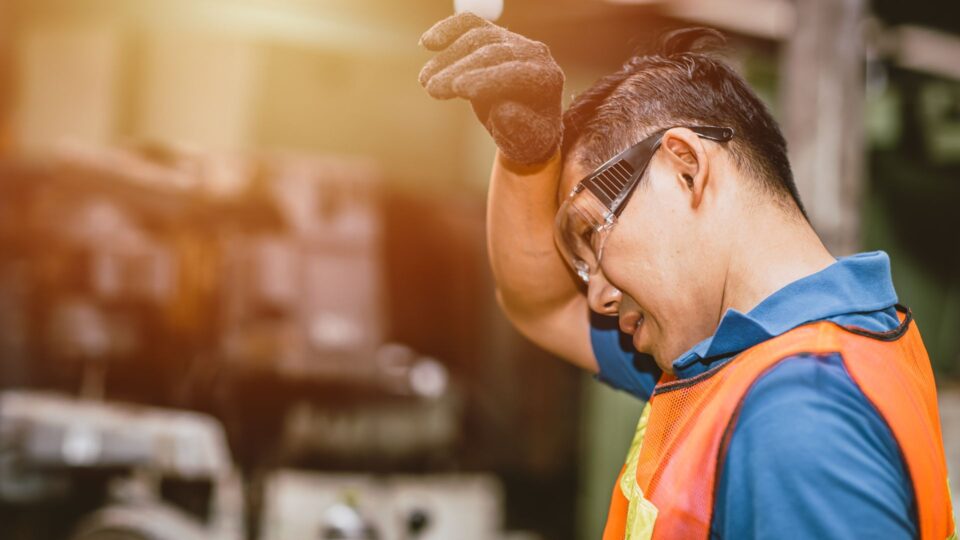A study of common methods to keep cool was performed on 1719 people in the Australian labour fource. It revealed that 88% of workers would stay hydrated to combat the heat. Additional to hydration, 44% would also rest, and 67% would cool themselves. Alarmingly, 10% opted to change jobs to remove themselves from heat stress in the workplace.
If your warehouse workers are overheating, it’s more than likely they will spend time trying to stay cool. Trying to stay cool may mean moving away from the work area, pausing production, or other activities that hault their job responsibilities. Needing to do this to stay cool not only decreases their job satisfaction but their productivity levels.
Everyone in the workplace has health and safety duties to stay cool and safe. Keep reading as we explore the common signs of heat stress in warehouse workers and the best ways to tackle heat stress and maintain consistent productivity.
What is heat stress?
Heat stress is a condition that occurs due to prolonged exposure to high temperatures. If your body is overheating, it will start to control its internal and external temperature. Heat stress occurs when your body can control this internal temperature fails.
You will not be able to get rid of excess heat inside the body, leading to a rising core temperature and heart rate. High temperatures can cause heat stress; your body’s work rate is also a contributing factor. Employers have a responsibility to provide proper cooling and hydration for their workers to avoid heat stress.
Common signs of heat stress in warehouse workers
How do you know if your workers are suffering from heat stress? Let’s discuss the common signs and symptoms of heat stress.
Heat cramps
Heat cramps are involuntary and painful spasms in the muscles. They mostly occur with heavy exercise in hot environments. When your body is not hydrated and suffers from electrolyte depletion, these cramps can become severe and prolonged. This condition may be accompanied by heavy sweating, fatigue, thirst, and muscle cramps.
Heat exhaustion
Heat exhaustion is a severe health condition that requires immediate first aid action. The first signs of heat exhaustion include:
- Heavy or excessive sweating
- Weakness and fatigue
- Cool, pale, or clammy skin
- Weakened or quickened pulse
- Nausea and vomiting
- Headaches and fainting
If you spot these signs in your workers, you should immediately move them to a cooler, air-conditioned environment and loosen their clothing to promote blood flow, helping the body to cool down.
Heat syncope
Heat syncope occurs when you are sedentary and stand up too quickly or when you have been standing for too long. It is a fainting episode or dizziness caused by a lack of acclimatisation to heat or dehydration. This is a mild form of heat illness, and the best treatment includes lowering the body temperature with a colder environment or cold shower.
Heat stroke
Heat stroke is a very extreme form of heat illness. The symptoms of heat stroke include:
- Confusion, slurred speech, altered mental status.
- Loss of consciousness.
- Excessive sweating or hot and dry skin.
- Seizures.
- Very high body temperature.
- Fatality without proper treatment.
To treat heat stroke, immerse yourself in cold water as soon as possible to lower your body temperature. The faster you immerse yourself in cold water, the less you risk organ failure and death. Evaporation cooling techniques can also be effective.
Tips for avoiding heat stress in the workplace
Heat stress is detrimental to workplace productivity and can lead to serious health complications for workers – which is why you should take preventative action.
Hydrate
Keeping your workers hydrated is essential to combat heat stress in the workplace. Water helps the body to remove heat through sweating and evaporative cooling. Without sufficient hydration, the body cannot perform evaporative cooling processes, and heat will become trapped in the body.
Encourage your workers to hydrate themselves properly and reduce the impact of warehouse heat.
Ventilate
Ventilation is essential for warehouse cooling. It helps to improve air quality and remove pollutants produced by warehouse processes. It also increases the air exchange rate, removing hot air and providing a steady fresh, cool airflow.
Metal warehouses can quickly become heat traps in hot climates, so ventilation should be a priority. Consider investing in mobile mancoolers to provide a maneuverable ventilation solution, ensuring your workers always have a gentle breeze while working. Mini mancoolers can be effective in a smaller scale facility and are easier to move for more flexibility.

Circulate
Air circulation also provides a steady airflow exchange, helping to ensure even temperatures throughout your facility. An air circulator ensures no hot air pockets in your facility, ensuring your cooling equipment works optimally.

Dehumidify
Humidity can make your working environment feel hotter. When there is a higher amount of humidity, the moisture produced by sweating stays on our skin for longer, making us feel even hotter. A dehumidifier or mancooler helps reduce the air’s humidity to aid the body’s natural evaporative cooling processes.
Choose Fanquip for warehouse cooling equipment
As an employer, you must understand the risk heat poses to your employees. Investing in ventilation, air circulation, and humidity control for your facility can create a more pleasant work environment and keep your workers safe. Plenty of water will also help support your workers’ bodies in managing heat.
Fanquip has ventilation and cooling system experts on hand to help you create a cooler working environment for your employees. Contact us today to develop your ventilation and cooling strategy.
